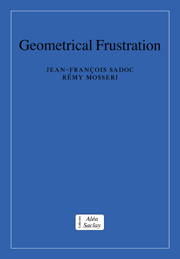Book contents
- Frontmatter
- Contents
- Preface
- 1 Introduction to geometrical frustration
- 2 Ideal models
- 3 Finite structures
- 4 Decurving and disclinations
- 5 Hierarchical polytopes
- 6 Some physical properties
- 7 Periodic structures with large cells
- 8 Quasiperiodic order and frustration
- A1 Spaces with constant curvature
- A2 Quaternions and related groups
- A3 Hopf fibration
- A4 Polytopes and honeycombs
- A5 Polytope {3, 3, 5}
- A6 Frank and Kasper coordination polyhedra
- A7 Quasiperiodic tilings: cut and projection
- A8 Differential geometry and parallel transport
- A9 Icosahedral quasicrystals and the E8 lattice
- Bibliography
- Index
5 - Hierarchical polytopes
Published online by Cambridge University Press: 06 January 2010
- Frontmatter
- Contents
- Preface
- 1 Introduction to geometrical frustration
- 2 Ideal models
- 3 Finite structures
- 4 Decurving and disclinations
- 5 Hierarchical polytopes
- 6 Some physical properties
- 7 Periodic structures with large cells
- 8 Quasiperiodic order and frustration
- A1 Spaces with constant curvature
- A2 Quaternions and related groups
- A3 Hopf fibration
- A4 Polytopes and honeycombs
- A5 Polytope {3, 3, 5}
- A6 Frank and Kasper coordination polyhedra
- A7 Quasiperiodic tilings: cut and projection
- A8 Differential geometry and parallel transport
- A9 Icosahedral quasicrystals and the E8 lattice
- Bibliography
- Index
Summary
Hierarchical polytopes and symmetry groups
Symmetry group of the {3, 3, 5} polytope and homotopy theory of defects
Line defects in condensed media can be classified using the homotopy theory (Toulouse and Kléman 1976), which allows us to identify the possible defects and to analyse their mutual relationships (Rivier and Duffy 1982). In the polytope {3, 3, 5}, linear defects are given by the conjugacy classes of the fundamental group π1(SO(4)/G′) where G′ is the direct symmetry group of the polytope (Nelson and Widom 1984).
The polytope full symmetry group is presented in appendix A2, §3 using quaternions and in appendix 4 using the orthoscheme description. It contains 14 400 elements while the direct group G′ contains 7200 elements. It is related to the icosahedral group Y by: G′ = Y′ × Y′ / Z2, where Z2 is a two element group and Y′, of order 120, is the lift of the R3 icosahedral group Y into SU(2) (SU(2) is isomorphic to the group of unit quaternions). This shows that elements of G′ can be described as a combination of screws (sometimes called ‘double rotations’). Related defects also combine several screws along different axes, leading to ‘dispirations’ similar to those introduced by Harris (see §4.1).
Among these defects are those related to 2π/5 rotations. The introduction of two interlaced disclinations of this kind into the polytope {3, 3, 5} has already been presented in chapter 4.
- Type
- Chapter
- Information
- Geometrical Frustration , pp. 100 - 127Publisher: Cambridge University PressPrint publication year: 1999



